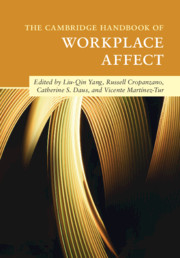Book contents
- The Cambridge Handbook of Workplace Affect
- The Cambridge Handbook of Workplace Affect
- Copyright page
- Contents
- Figures
- Tables
- Contributors
- Foreword
- Part I Theoretical and Methodological Foundations
- Part II Workplace Affect and Individual Worker Outcomes
- 8 Affect, Stress, and Health
- 9 Emotion and Various Forms of Job Performance
- 10 The Role of Affect and Its Regulation for Creativity and Innovation
- 11 Emotional Labor
- 12 Advancing the Field
- 13 Affect and Workplace Judgment and Decision-Making
- 14 The Mindful Emotion Management Framework
- 15 Benefits of Negative Affective States
- 16 Interventions to Improve Employee Well-Being
- Part III Workplace Affect and Interpersonal and Team-Level Processes
- Part IV Workplace Affect and Organizational, Social, and Cultural Processes
- Part V Discrete Emotions at Work
- Part VI New Perspectives on Workplace Affect
- Index
- References
13 - Affect and Workplace Judgment and Decision-Making
from Part II - Workplace Affect and Individual Worker Outcomes
Published online by Cambridge University Press: 25 June 2020
- The Cambridge Handbook of Workplace Affect
- The Cambridge Handbook of Workplace Affect
- Copyright page
- Contents
- Figures
- Tables
- Contributors
- Foreword
- Part I Theoretical and Methodological Foundations
- Part II Workplace Affect and Individual Worker Outcomes
- 8 Affect, Stress, and Health
- 9 Emotion and Various Forms of Job Performance
- 10 The Role of Affect and Its Regulation for Creativity and Innovation
- 11 Emotional Labor
- 12 Advancing the Field
- 13 Affect and Workplace Judgment and Decision-Making
- 14 The Mindful Emotion Management Framework
- 15 Benefits of Negative Affective States
- 16 Interventions to Improve Employee Well-Being
- Part III Workplace Affect and Interpersonal and Team-Level Processes
- Part IV Workplace Affect and Organizational, Social, and Cultural Processes
- Part V Discrete Emotions at Work
- Part VI New Perspectives on Workplace Affect
- Index
- References
Summary
Judgment and decision-making (JDM) are ubiquitous within organizations. Leaders initiate critical judgments and decisions about organizational strategy and operating procedures. Continuous judgments and decisions are generated relating to the recruitment, selection, performance management, and departure of organizational talent. Every employee makes judgments and decisions on career directions, task acceptance, resource use, and time allocations across both work and non-work tasks. Employees generate frequent high-stakes judgments and decisions in courtrooms, as well as split-second decisions in emergency rooms and cockpits. It is hard to imagine workplace decisions and judgments such as these occurring without affective processes being involved.
- Type
- Chapter
- Information
- The Cambridge Handbook of Workplace Affect , pp. 174 - 184Publisher: Cambridge University PressPrint publication year: 2020
References
- 2
- Cited by



